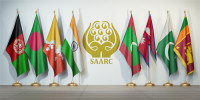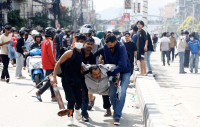Opinion
Undying persistence
Professor Kamal Prakash Malla, alias Malla Sir (1936-2018), passed away on 17 November 2018 in America.
Professor Kamal Prakash Malla, alias Malla Sir (1936-2018), passed away on 17 November 2018 in America. He was struggling from various ailments for some time.
That news hit quite close to home because he was my own guru; he was my teacher when I joined Tribhuvan University in early 1967 to pursue a Master of Arts in English, and he retired in late 1999 when I was the chairman of the same department.
He taught me, among other things, how to approach modernity in literature and treat criticism as an important element of literary discourse. But that was not all. His philosophy of pragmatism and his capacity to sift through a vast amount of knowledge to interpret history and quotidian life inspired me deeply.
His method of uncovering the interface between cultural matters and the politics of knowledge—which he achieved by writing about the intelligentsia, educational achievements and failings—was also one of his many talents. He also explored the dialogical relationship between poetry and art, language and culture, sculptures and artefacts in innovative and unprecedented ways.
He made important contributions to the study of Newar language, culture and people and captured the discrimination that they suffered in their struggle for language rights. The memory of Malla sir that I paint here represents only an excerpt of the views that I expressed on February 10, 2015 at the launch of Malla’s magnum opus From Literature to Culture: Selected Writings on Nepalese Studies, 1980-2010, published by Himal Books.
Stories of our time
The tone of KP Malla’s well-researched articles—which were written during a period of time that was important in the life of a nation that experienced different political, social and cultural challenges—have prompted many important discussions on culture and power.
His contributions came precisely at a time when the nations of South Asia or Asia, for that matter, were trying to consolidate their achievements made in the post-colonial times. India, after independence, was opening all possible fronts in their approach to national progress, including the effort to acquire economic, political and educational stability. Importantly, it opened up many avenues for further studies in the realm of culture and literature, which can be considered the soul of any nation.
In Nepal too, we have experienced changes, and made experiments of both obscurantist and forward-looking natures. But we do not find many succinct analyses of this important period in native writings. We always tended to rely on foreign writers and interpreters’ works to understand the visible, tangible, the covert and intangible features of a vertical nation that was trying to develop.
I stress vertical because the texture of history at the time was being created by a hierarchical power structure with the monarchy at the helm of affairs deciding which turns the country should take and what would suit their concept of nationalism and integrity. A pattern of power and culture was being created to support that. This subtle process represents the tendencies of, in Antonio Gramsci terms, ‘astute power holders’ who keep the cultural front open, but tighten the power mechanism including the military. Malla Sir’s essays effectively capture those important and often overlooked subtleties. In each of these essays, we see how power had or had been ‘percolating’ through the veins of the society. Malla exposes that process in a bold, critical, academic, and well-researched manner.
Malla’s essays in his work including his reprint of Road to Nowhere should draw crowds—of sociologists, archaeologists, linguists, and historians of dynamic forms—in vibrant discussion.
A political leader could come here to speak, too, if he ever bothered to read these writings. A literary critic, one who would understand T.S. Eliot’s Four Quartets or the Waste Land could equally stake his claim to speak. His work speaks to a variety of audiences and unites disciplines and historical approaches.
Uniting disciplines and communities
I would say, this book is a repository of knowledge, a rainbow of what we have done and seen over the decades. Malla’s predictions, his warnings against adopting a monolithic line of nationalism and a static form of national identity as it would establish the authority of one group of elites over some caste groups, were extremely important and continue to remain relevant in Nepali affairs. What could be a more accurate prediction considering what is happening today? However, Malla’s view is not one that leads to an apocalypse but one that leads towards solutions. The point he makes is: If you work carefully, if you understand the value of this heritage, these people and this land, the culture, the topography and the sheer spatial significance of the architectural and urban planning, you will make this country a very liveable and meaningful place.
Malla has analysed power relations in a number of essays. He has spoken about liberal education, interestingly, without hiding his love for King Birendra, whom he considered a great promoter of that, based on his personal experience with the king. Malla Sir has written extensively on how he worked with he establishments, foreign experts, indigenous groups, colleagues and students like Nirmal Man Tuladhar and I, in these essays. In one article published in 2010, he presented some of his disillusioned views by putting himself in it.
Here it would be appropriate to cite what Malla says about his cultural odyssey. He says, ‘During the last three decades, between 1979-2009, I studied medieval Newari texts, literary, historical and epigraphic, edited/translated some, compiled words from these, coordinated a major lexicon-cum-dictionary project comprising a database of nearly 56,000 older words. I find that some of the documents compiled here read like a jigsaw puzzle.’ But he did many other things during this period of time. That was Malla Sir’s strength: his undying persistence. The big book compiles many of his other writings during these three decades, and captures his strength, versatility, power and restlessness.
Our history as well as our present continually warrant new linkages with Kamal Prakash Malla’s diverse and researched musings because we find great messages in them.
A unifying thread of our problems, achievements, weaknesses, hypocrisies, greedy tendencies, talents and genius runs through all of his work.To study Malla Sir’s works carefully and decode their pragmatic messages would be the best tribute that we could pay to him today.




 9.12°C Kathmandu
9.12°C Kathmandu









